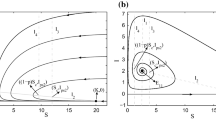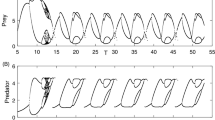Abstract.
A state-dependent impulsive model is proposed for integrated pest management (IPM). IPM involves combining biological, mechanical, and chemical tactics to reduce pest numbers to tolerable levels after a pest population has reached its economic threshold (ET). The complete expression of an orbitally asymptotically stable periodic solution to the model with a maximum value no larger than the given ET is presented, the existence of which implies that pests can be controlled at or below their ET levels. We also prove that there is no periodic solution with order larger than or equal to three, except for one special case, by using the properties of the LambertW function and Poincaré map. Moreover, we show that the existence of an order two periodic solution implies the existence of an order one periodic solution. Various positive invariant sets and attractors of this impulsive semi-dynamical system are described and discussed. In particular, several horseshoe-like attractors, whose interiors can simultaneously contain stable order 1 periodic solutions and order 2 periodic solutions, are found and the interior structure of the horseshoe-like attractors is discussed. Finally, the largest invariant set and the sufficient conditions which guarantee the global orbital and asymptotic stability of the order 1 periodic solution in the meaningful domain for the system are given using the Lyapunov function. Our results show that, in theory, a pest can be controlled such that its population size is no larger than its ET by applying effects impulsively once, twice, or at most, a finite number of times, or according to a periodic regime. Moreover, our theoretical work suggests how IPM strategies could be used to alter the levels of the ET in the farmers’ favour.
Similar content being viewed by others
References
Andronov, A.A., Leontovich, E.A., Gordan, L.L., Maier, A.G.: Qualitative theory of second-order dynamic systems. Translated from Russian by D. Louvish, John Wiley & Sons, New York, 1973
Bainov, D.D., Simeonov, P.S.: Impulsive differential equations: periodic solutions and applications, Pitman Monographs and Surveys in Pure and Appl. Math. 66, (1993)
Bainov, D.D., Simeonov, P.S.: Systems with impulse effect, theory and applications, Ellis Hardwood series in Mathematics and its Applications, Ellis Hardwood, Chichester, 1989
Barclay, H.J.: Models for pest control using predator release, habitat management and pesticide release in combination. J. Appl. Ecol. 19, 337–348 (1982)
Chellaboina, V.S., Bhat, S.P., Haddad, W.M.: An invariance principle for nonlinear hybrid and impulsive dynamical systems. Nonlinear Anal. TMA 53, 527–550 (2003)
Corless, R.M., Gonnet, G.H., Hare, D.E.G., Jeffrey, D.J., Knuth, D.E.: On The Lambert W Function. Adv. Comput. Math. 5, 329–359 (1996)
Flint, M.L., ed.: Integrated Pest Management for Walnuts, University of California Statewide Integrated Pest Management Project, Division of Agriculture and Natural Resources, Second Edition, University of California, Oakland, CA, publication 3270, 1987, pp. 3641
Grasman, J., Van Herwaarden, O.A., Hemerik, L., Van Lenteren, J.C.: A two-component model of host-parasitoid interactions: determination of the size of inundative releases of parasitoids in biological pest control. Math. Biosci. 169, 207–216 (2001)
Greathead, D.J.: Natural enemies of tropical locusts and grasshoppers: their impact and potential as biological control agents. In: C.J. Lomer, C. Prior (eds.), Biological control of locusts and grasshoppers. Wallingford, UK: C.A.B. International, 1992, pp. 105–121
Guckenheimer, J., Holmes, P.: Nonlinear oscillations, dynamical systems, and bifurcations of vector fields. Appl. Math. Sci. 42, (1983)
Kaul, S.: On impulsive semidynamical systems. J. Math. Anal. Appl. 150, 120–128 (1990)
Lakshmikantham, V., Bainov, D.D., Simeonov, P.S.: Theory of impulsive differential equations. World Scientific series in Modern Mathematics, Vol. 6, Singapore, 1989
Matveev, A.S., Savkin, A.V.: Qualitative theory of hybrid dynamical systems. Birkhäuser, 2000
Pedigo, L.P., Higley, L.G.: A new perspective of the economic injury level concept and environmental quality. Am. Entomologist 38, 12–20 (1992)
Pedigo, L.P.: Entomology and Pest Management. Second Edition. Prentice-Hall Pub., Englewood Cliffs, NJ, 1996, p. 679
Qi, J.G., Fu, X.L.: Existence of limit cycles of impulsive differential equations with impulses as variable times. Nonl. Anal. TMA 44, 345–353 (2001)
Simeonov, P.S., Bainov, D.D.: Orbital stability of periodic solutions of autonomous systems with impulsive effect. INT. J. Syst. SCI 19, 2561–2585 (1988)
Stern, V.M., Smith, R.F., van den Bosch, R., Hagen, K.S.: The integrated control concept. Hilgardia 29, 81–93 (1959)
Stern, V.M.: Economic Thresholds. Ann. Rev. Entomol., 259–280 (1973)
Tang, S.Y., Chen, L.S.: Density-dependent birth rate, birth pulses and their population dynamic consequences. J. Math. Biol. 44, 185–199 (2002)
Tang, S.Y., Chen, L.S.: Multiple attractors in stage-structured population models with birth pulses. Bull. Math. Biol. 65, 479–495 (2003)
Tang, S.Y., Chen, L.S.: The effect of seasonal harvesting on stage-structured population models. J. Math. Biol. 48, 357–374 (2004a)
Tang, S.Y., Chen, L.S.: Modelling and analysis of integrated pest management strategy. Disc. Continuous Dyn. Syst. B 4, 759–768 (2004b)
Tang, S.Y., Chen, L.S.: Global attractivity in a “food limited” population model with impulsive effects. J. Math. Anal. Appl. 292, 211–221 (2004c)
Van Lenteren, J.C.: Integrated pest management in protected crops. In: Dent, D., (ed.), Integrated pest management, Chapman & Hall, London, 1995, pp. 311–320
Van Lenteren, J.C.: Measures of success in biological control of arthropods by augmentation of natural enemies. In: Wratten, S., Gurr G. (eds.), Measures of Success in Biological Control, Kluwer Academic Publishers, Dordrecht, 2000, pp. 77–89
Van Lenteren, J.C., Woets, J.: Biological and integrated pest control in greenhouses. Ann. Rev. Ent. 33, 239–250 (1988)
Volterra, V.: Variations and fluctuations of a number of individuals in animal species living together. Translation In: R.N. Chapman: Animal Ecology, New York: McGraw Hill, 1931, pp. 409–448
Xiao, Y.N., Van Den Bosch, F.: The dynamics of an eco-epidemic model with biological control. Ecol. Modelling 168, 203–214 (2003)
Author information
Authors and Affiliations
Corresponding author
Additional information
Mathematics Subject Classifications (2000): 34A36, 34D45, 92B05, 34C25
Acknowledgement The authors thank Professor L.S. Chen for support and encouragement in this research, as well as Y.N. Xiao for fruitful discussions. We would also like to thank the referees for their careful reading of the original manuscript and many valuable comments and suggestions, including the new method of proving proposition 2.1 attached in Appendix, that greatly improved the presentation of this paper.
Rights and permissions
About this article
Cite this article
Tang, S., Cheke, R. State-dependent impulsive models of integrated pest management (IPM) strategies and their dynamic consequences. J. Math. Biol. 50, 257–292 (2005). https://doi.org/10.1007/s00285-004-0290-6
Received:
Revised:
Published:
Issue Date:
DOI: https://doi.org/10.1007/s00285-004-0290-6




